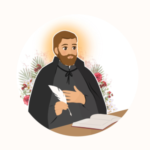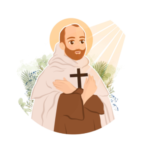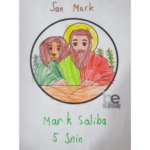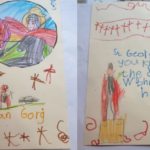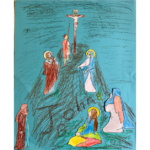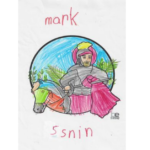
What is Advent?
The Church offers us this time to help us pause and prepare ourselves for the feast of Christmas. It could very well happen that the daily busyness of life, the children’s activities, the buying of gifts, home decorations and preparations of lunches, dinners, and parties, leave us breathless. We can easliy miss out on the scope of what this time should really be. Let us not allow ourselves fall into the trap of allowing Christmas to become just a celebration which has nothing to do with God becoming man – God’s invitation of being born in us.
Advent means waiting. The aim of this resource is to help families with young children (it is in fact primarily addressed to parents) to live Advent as intended and Jesus will be the centre of the Christmas celebration. The four weeks of Advent are a preparation for Christmas. The Bible, as you know, is divided into two main sections: the Old and the New Testament. One can say that the Old Testament is like Advent time! God promised a Saviour and across the ages, the People of God prepared and waited for the coming of the Messiah. We know that this time of waiting, spread over many and many years.
This resource includes activities, reading and listening to Bible stories and prayer time. As the title implies, seek to turn this time into an adventure for your children, with moments of discovery, joy and love.
We invite you to accept this invitation, so that as a family you live this special time of Advent and Christmas, together with the joy that baby Jesus brings. Each section starts with a short note addressed to you, to give you more insight about that particular day or feast.
This resource is spread over 7 weeks, starting from the first Sunday of Advent up to the Solemnity of the Epiphany of Our Lord. Each week is further divided into 7 sections:
- Let us watch …this section will have a video link
- Let us listen … a reading from the Bible. Preferably the stories are read from a children’s Bible, so that the language is more appropriate. If you do not have one, read the episode from the Bible and explain any difficult words that you may encounter
- Let us retell … the children will be preparing some puppets. Using these puppets, the children will recount the story that they have heard
- Let’s do … what will we do, after listening to this passage?
- Let’s enjoy ourselves … this section includes activities
- Let us pray … we pray together as a family
- Let’s prepare … the children will prepare the puppets for the next week. So that you have the puppets for the first week ready, the children have the pictures of Virgin Mary and Angel Gabriel. Print these on white construction paper or else glue them onto construction paper afterwards, so that they are firmer. After colouring them, help them to cut them out and on the back, they stick a craft/lollipop or kebab stick. Wide masking tape may be used to fix the stick to the picture. Some of the characters may be used more than once.
During the weeks of Advent, the children may also prepare and Advent Wreath. This is a tradition with a clear message. It is also easy to make. The wreath may be bought or you can do it together from scratch.
You will need:
- A green wreath
- 3 purple candles
- 1 rose (pink) candle
- 1 big white candle
- 4 smaller white candles, so that the wreath may also be used during Christmas time
- During Advent decorate the wreath sparsely, use pinecones for example. For Christmas, the wreath may be decorated with more things, to your liking.
A number of parishes bless the wreaths on the first Sunday of Advent. You may take your wreath to be blessed. Then put it in a central place, so that each week you may light a candle, sing a carol and read an episode from the Bible (preferably from the children’s edition). You may also continue to light the candles during the rest of the week, during dinner, for example.
The wreath is green and round. This symbolises the presence of God, who is always with us. It also represents God’s endless love for us. There are three purple candles. Purple reminds us of sacrifice and preparation. The fact that we need to change our way of life to make more space for Jesus, requires sacrifice. These candles are lit for the first, second and fourth Sunday of Advent. The pink or rose candle is lit on the third Sunday. This candle represents the joy that Jesus is soon to be born. The white candle is for Christmas. During Christmas Time, the purple and rose candles are replaced by white ones, and more decorations may be added.
The younger ones may also colour their Advent Wreath. You will need:
- Two shades of green construction paper
- Red construction paper
- 5 empty toilet paper rolls
- Pictures which will be glued onto the toilet paper rolls
- Colours
- Glue
- Scissors
Cut a circle from the lighter shade of green. This should be big enough to hold four toilet paper rolls on the outside and another one in the middle. Cut out leaves from the darker green paper and glue these on the outside perimeter, between the toilet paper rolls, to form a wreath. The flames are cut from the red construction paper and glued on top of the candle. Every week, the children may colour the picture of that week, glue it to the toilet paper roll and fix the flame, so that by Christmas, the wreath will be complete.
Download the following pictures to make the advent wreath:
Introduction to Advent
The first Sunday of Advent marks the start of the Liturgical Year (the Church Year).
It lasts for four Sundays, and it is a time of waiting and preparation for the birth of Jesus.
One way to celebrate this special time is to create an Advent wreath, you will surely see one in your church on the first Sunday of Advent.
Traditionally, Advent wreaths are circular in shape which symbolizes God’s constant and unchanging nature. Four candles are inserted representing the four weeks of Advent. Usually there are three purple and one rose candle, but white candles may also be used. A fifth candle is also placed in the centre of the wreath, it is white and represents the light of Christ. The purple candles symbolize the prayer, penance, sacrifices and good deeds which we take extra care to do during Advent. The rose candle is lit on the third Sunday, it’s called Gaudete Sunday and the Priest wears pink vestments at mass. It is a time of rejoicing halfway through Advent and getting closer to the feast of Christmas.
By lighting another candle each week, we are thinking and waiting with hope for the first time Jesus came to earth at his birth, but we are also thinking about the time when he will return to earth as he promised.
Week by week we are going to celebrate the four Sundays of Advent by making an Advent Lapbook, each week adding to it so we can truly appreciate the Season of Advent and prepare our hearts and minds for Jesus.
We will need
- To watch the video on How to make a Lapbook below.
- 2 card A4 document file folders (purple if possible)
- Glue stick
- Pencils/colours/scissors
- Coloured craft card
- Activity templates available to download each week



